July 31, 2020, by Dr. Meghan Gray
On Stars, Ciphers, and Cigarettes
Guest post by Floe Foxon (BSc Physics and Astronomy, 2020), whose final year of undergraduate studies featured international travel, research, published papers, and ultimately a job offer. Congratulations Floe on all your accomplishments!
What do stellar reactors, medieval cryptograms, and smokes have in common? Probably nothing. Regardless, the final year of my BSc in Physics with Astronomy at Nottingham was dominated by stars, ciphers, and cigarettes.
The Bit About Cigarettes.
“Where do you see yourself in five years?” – Every job interview ever.
It’s probably fair to say that most people dread this question; the future feels very far away, and deciding now, right now, what you want to do with your future seems rather… pre-emptive. After all, nobody wants to be sitting around five years from now asking themselves ‘Did I make the right choice?’
But young people today face immense pressure to compartmentalize their lives this way very early on. Choosing your academic discipline can feel like imposing a strong restriction on your own future. Is it already too late to change your mind?
Like many students, I pursued a Summer internship out of financial necessity; living under modern capitalism is grossly expensive. Initially I was determined to seek something in Physics. Why anything else? ‘Social science is a bit naff’, I told myself.
However, the opportunity was never to be found; reluctantly, I had no choice but to consider other disciplines.
I happened upon a 10 week internship in the quiet city of Sioux Falls, South Dakota. To my own surprise, something about this clicked with me, and I inquired. One researcher’s portfolio caught my eye; a quantitative specialist in the behavioural science of nicotine and tobacco. In particular, a focus on the harm-reduction potential of e-cigarettes. I figured ‘why not?’, and with the written support of my tutor Dr Simon Dye, and my lab teacher Paul Munday, I submitted my application and waited…
Ultimately I was accepted onto the program. With a visa in my hand, I boarded a plane to the United States, my first ever flight, the very next day after finishing my Spring semester exams.
It’s safe to say my expectations were vastly exceeded. During my first two weeks of research, I was tasked with completing a literature review, as well as familiarising myself with the data available to me, and what I might do with them. Once a research project had been discussed, planned, and agreed upon with my advisor, I was free to research independently. Armed with Python and a Physics background, I spent each day analysing and interpreting youth nicotine use data, and just in time for the completion of the course, I was able to compile and submit my first manuscript for peer review as first author. This article has since been published in Addiction, a long-standing high-impact journal on pharmacological and behavioural addictions. The paper, titled ‘Electronic cigarettes, nicotine use trends and use initiation ages among US adolescents from 1999 to 2018’ (not the catchiest name, I know) has so far received two citations and 341 tweets. Suffice to say, the internship I was once hesitant about turned into something wonderful for my career.
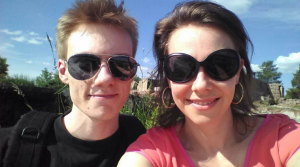
Floe with Dr Arielle Selya
To my surprise, I found myself not only applying similar analyses to those I had learned in the undergraduate lab, but thoroughly enjoying each moment of it. It turns out that you aren’t necessarily constrained to the discipline you first choose; instead I discovered the only limit to interdisciplinarity is your ability to apply something you know to something you don’t. While the system of choices isn’t perfect, some assurance can be taken in knowing that the opportunities to branch out don’t end when you pick your discipline. “Discipline is never an end in itself, only a means to an end.”
One of the obvious benefits of doing an international internship is the ability to travel. In the case of the United States, an intern is allowed a 30 day grace period to leave the country after the expiration of their visa. This gave me the ability to travel for a month after finishing up my research, using the stipend I was granted.
South Dakota is often pejoratively considered to be ‘flyover country’, with the implication that the place is somewhat empty. But there is beauty to be found in emptiness, as I observed when I visited the Badlands National park; a geological wonder of buttes and pinnacles eroded from the Brule formation. Additionally, I paid a visit to the Hot Springs Mammoth site; an active excavation of Ice Age mammal remains, and the Badlands Petrified Gardens; a park full of fossilized wood.

Floe in the Badlands of South Dakota
I was also fortunate enough to visit the work-in-progress Crazy Horse Memorial; a monument to the courageous Lakotan Tȟašúŋke Witkó (which literally translates to ‘his horse is crazy’), who decisively defeated Major General Custer at the Battle of the Little Bighorn.
Finally, I embarked on a road trip to Seattle, Washington, where I visited the Space Needle, the Chihuly Garden and Glass, and stood below the statue of the influential Vladimir Ilyich Ulyanov: Lenin.
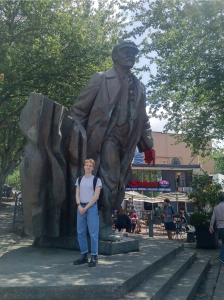
Floe with Lenin
The Bit About Ciphers.
“I am the modern man who hides behind a mask, so no one else can see my true identity” – Styx
Returning from my travels with a newfound passion for independent research, I explored some ideas that had been floating around in my mind concerning cryptograms. Cryptograms are coded pieces of text which disguise an underlying message from watchful eyes. I first became interested in cryptography when learning about the Zodiac killer; a 1960s serial killer infamous for taunting authorities with cryptograms, most of which remain unsolved. One possible method of encryption employed in these ciphers is the Homophonic Substitution method, in which each character in the plain text message maps onto two or more cipher characters in the ciphertext, thus frustrating traditional decrpytion attempts.
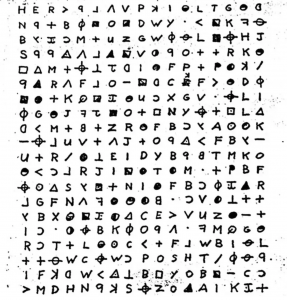
A cipher from the Zodiac Killer
After thinking awhile about these kinds of cryptograms, I developed a probability-based method of reducing the key space (that is the set of possible keys containing the real encrytion key) for brute-force approaches to breaking the codes. My second paper, titled ‘Finding Probable Frequency Sums to Reduce the Key Space of Homophonic Substitution Ciphers’ (I know, I have a real knack for titles which never end) was peer reviewed and published in an undergraduate journal; ideal for student works which go beyond undergraduate knowledge, but which may not easily fit into traditional journals like Addiction.
The Bit About Stars.
“To begin at the beginning: It is spring, moonless night in the small town, starless and bibleblack…” – Dylan Thomas
More confident now in my ability to produce research independently, I returned to my studies at the commencement of my final year. As BSc students know, the third year involves a project in which the student conducts an extended investigation into some physics topic. Returning to my roots in Astronomy, I aimed my sights at the nuclear processes of Stars. Just as I had applied physics methods to my social sciences research, the plan now was to employ simulation methods I had learned in the social sciences to physical processes. What resulted was the world’s first (to my knowledge) System Dynamics model of a Main Sequence Star. Condensing my project into a short article, I submitted my work to an Astronomy journal where it is now under peer review.
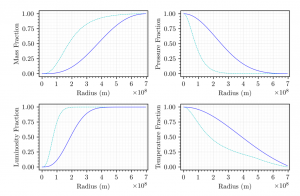
Stellar structure simulation results. Floe’s simulation results represented by the continuous line, Yale researcher’s results represented by the dashed line.
It was no easy feat publishing three papers in less than a year, and in all likelihood it wouldn’t have been possible without the support of the staff here at the School of Physics & Astronomy in Nottingham, my advisor in the States, and a whole lot of listening to the new Tool album.
The Aftermath.
After being informed about the Society for Research on Nicotine and Tobacco (SRNT) annual conference, I submitted my e-cigarette research article for consideration as a conference paper. This year, the conference took place in New Orleans, Louisiana, and was hosted at the Hilton Riverside. Thankfully, I was successful in obtaining a spot at the poster session to present my findings to other researchers in the field. I flew once more to America in March, and there I met a plethora of likeminded scientists. Impressed with my findings and sympathetic to the finances of a student, I was offered some consulting work by Action on Smoking and Health (ASH), an influential UK public health charity. My work for ASH was recently presented to the All Party Parliamentary Group, included in their press release (my contribution was the ‘new analysis… shows that if the number of children taking up smoking had not declined as it did, an additional five hundred children a day would be taking up
smoking’).
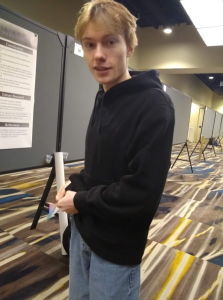
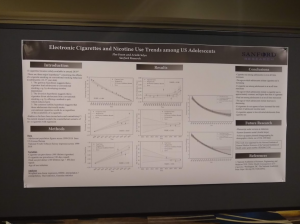
Floe’s poster at SRNT
The astute reader will notice that the conference began as the global COVID-19 pandemic took off. Indeed, travel disruptions caused my return flights to be cancelled time and again. Fortunately, I was offered a place to stay by a comrade State-side until travel stabilised. With luck, I was able to return to the UK to complete my final exams.
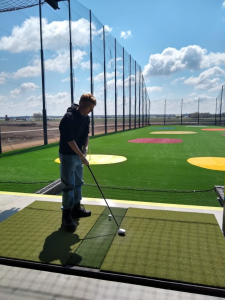
Floe golfing under lockdown in America (with social distancing, of course)
Finally, at the end of these adventures and after graduating with a hard-earned First Class degree, I was brought along for a job by my American advisor. As of July 1st, I am now a full-time consultant for Pinney Associates; a science and policy organisation which specialises in research for clients in pharmaceuticals and consumer healthcare.
It has been a stressful, exhausting, but ultimately rewarding ride. How did I get here? Mostly luck, to be sure – and a lot of support from the wonderful people around me in Nottingham and beyond. But perhaps also I wouldn’t be where I am if I hadn’t opened my eyes to the possibilities of diving into uncharted waters, relentlessly pursuing opportunities, and overcoming the boundaries of discipline.
Now to see what happens next…
No comments yet, fill out a comment to be the first

Leave a Reply